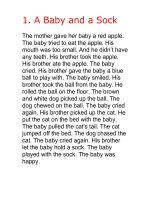MẸO dạy đoạn Hội thoại tiếng Anh - Conversation cho trẻ em hay, vui nhộn, hiệu quả nhất
Bạn đang xem bản rút gọn của tài liệu. Xem và tải ngay bản đầy đủ của tài liệu tại đây (135.01 KB, 9 trang )
HOW TO
TEACH
How to teach conversation
Step 1: Have Sts look at the picture carefully and answer some questions
related to the picture
Tips: Speaking out the English words Sts know in the conversation
Step 2: Sts listen and read silently and then listen and repeat after the
recording
Step 3: Ask Sts to translate the conversation into Vietnamese
Step 4: Role-play the conversation with a partner (without if can)
Note: focus on pronunciation and intonation
Step 5: Sts write the knowledge in their notebook, underline or highlight
markers to color the key words, main structures
How to teach conversation
Step 6:
- Look for: tìm kiếm
Eg: I’m looking for a new job.
- can/ can’t + V(inf): có thể/ không thể làm gì
Eg: She can play tennis.
Tom can’t speak Vietnamese.
Homework: You change information in the conversation based on your
way.
What color is it?
→ It’s + color.
Game 1: Musical conversation
Have Sts move around the room while T plays music.
When T stops the music, Sts begin conversations with the S closest to them.
They use conversation in the textbook as a model, add some information Sts
want.
Note: When you turn up the volume, Sts shout to begin conversations with the Sts
closest to them.
Game 2: Create
After learning a dialogue, have them workin groups or in pairs, creating a similar
conversation.
Have them practice as a conversation in pairs or groups
Have them change partners. The teacher should help the Sts express their ideas.
Eg:
A: Who’s that?
B: It’s my father.
A: What’s his job?
B: He’s a doctor.
A: Who’s that?
B: It’s my mother.
A: What’s her job?
B: She’s a teacher.
Game 3: Say it with Feeling
Explain the task. Sts listen to the audio, focusing on the speaker’s intonation and
emotions (angry, happy, surprise,…)
Play the audio. Ask Sts to repeat selected phrases with the correct intonation.
Encourage them to exaggerate the intonation. They can also add gestures, if
appropriate
Sts practise the conversation in pairs using lots of intonation. Then they change
roles and practise again.
Note: Ask pairs of Sts to perform the conversation in front of the class. The class
votes for the best performance.
Game 4: Look Up and Speak
Point out that it’s important to look at your partner when speaking
Explain the task. Sts work in pairs, S1 looks briefly at the first line of the
conversation and tries to remember it. Then S1 looks up at S2 and say the line. S2
looks briefly at the next line of the conversation, tries to remember it and then looks
up and says it.
Model the task with one or two Sts
Sts complete the task in pairs
Note: This technique works best when Sts stand up and face each other. It’s a
useful way to help Sts develop eye contact while speaking.
Game 5: Reorder
Sts work in groups
Give each group
reading/conversation/story
a
set
of
four
pictures/
sentences
in
the
Ask Sts to work in groups to reorder the reading/conversation/story then they
use glue to stick them in the A4-sized paper.
Game 6: True or False line
Put in line of tape on the floor and draw one
side “True” and the other “False”
T says a sentence in the lesson. If Sts think
the sentence T has said is correct, they jump
to the “True” side. And if not, they jump to
the “False” side.
Sts that jump to the wrong side are out of
the game and sit down.









